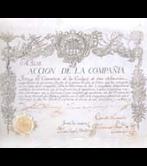La Real Compañía Guipuzcoana de Caracas
By the Royal Decree of 25th September 1728, the Real Compañía Guipuzcoana de Caracas (Royal Guipuzcoan Company of Caracas) was founded, with the authorisation to carry out reciprocal trade between the Kingdom of Spain and the province of Venezuela. The company continued until 1785, when it was refounded as the Compañía de Filipinas (Company of the Philippines). The aims of the Compañía Guipuzcoana were clear and well-defined: the Province of Gipuzkoa and the traders at the Consulate of San Sebastián were to take over Venezuela's trade in cocoa (which had until then arrived in Spain at high prices, supplied by the Dutch), and to sell manufactured goods in the colonies. Meanwhile, the King would prevent smuggling by foreigners (especially the Dutch) in the colony of Caracas. Furthermore, if the company prospered, it would increase the earnings of the Royal Treasury.
The company's trade was based on the following exchanges: on their outgoing voyages, ships leaving from the ports of Pasaia and Cádiz would transport Basque iron in all its different forms (nails, axes, railings, etc.), fabrics (mostly from abroad), haberdashery items and agricultural products from Andalusia (olive oil, olives, vinegar, liquors), as well as wine, liquors and flour from France. As for the cargos that ships brought back from Caracas, unquestionably the most important in terms of both volume and value was cocoa. But it was not the only product: other cargos regularly arriving included coffee, cotton and batches of tobacco and leather, which were mostly shipped on to Holland, especially tobacco.
On 15th July 1730, the first three ships set sail from the port of Pasaia, the company's centre of operations. They were the frigates San Joaquín and San Ignacio and the galley Santa Bárbara, armed with 86 cannons in all and crews totalling 561 men. The ships and their cargoes were insured with European insurance companies, a practice that was maintained with future voyages. Three months later a fourth vessel set sail, a large frigate. The results of these first trading expeditions were extraordinarily profitable for the company, as on their return voyage, two of these ships brought back 80,000 fanegas of cocoa (1 fanega = 1.5 bushels), purchased at a price of just 10 pesos and sold in Spain for 45 pesos, resulting in a net profit of 738,000 pesos.
In 1734, the Compañía Guipuzcoana reported to its shareholders (it was the first company in Spain to be set up according to the system of public shares) that it now possessed nine ships, a fact that highlights the company’s efforts to increase its volume of trade. During the course of its existence, the more than 70 ships belonging to the company created a fluid exchange route between Gipuzkoa, Cádiz and Venezuela. To this end, the Guipuzcoana had its own shipyard in Pasaia, where over half the fleet was built. The company also called on foreign shipping fleets when war or other such circumstances made it necessary.
The ships’ officers and crews were mostly from Gipuzkoa. Likewise, the shipbuilding that took place in the shipyards provided work for many people in the bay of Passaia. Apart from its own commercial profits, the Compañía was a driving force for the Guipuzcoan economy, to the extent that the Jesuit Larramendi complained that there were not enough young men in the coastal towns to work on the fishing boats, as so many had gone to work for the Compañía Guipuzcoana.




